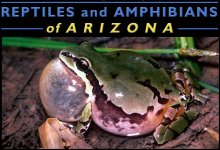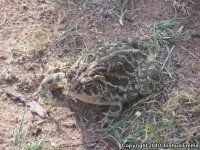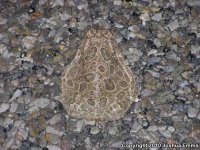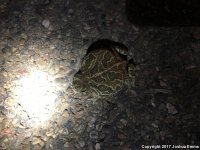| Range: |

|
| Other Names: |
|
| Description: |
Adult Great Plains Toads measure about 2.2 - 5.0 inches in length. Females average a slightly larger size than males. The cranial crests atop the head are prominent and join at the snout to form a large, bony boss. The left and right crests diverge posteriorly from the boss to form a "V" between the eyes. Dorsal coloration varies from gray, tan, olive, to yellowish-brown. Pale-bordered, dark dorsal blotches are usually in symmetrical pairs and often separated by a light mid-dorsal stripe, which may be faint or absent. The venter is white or cream, and normally unspotted. Male Great Plains toads have a light colored throat-flap covering the black vocal sac. The inflated vocal sac is distinctly sausage-shaped. Juvenile toads have numerous small brick-red tubercles. Tadpoles grow to about one inch, are dorsally black or dark gray, and have a highly arched tail fin. The dorsal color lightens and becomes patterned in tadpoles nearing metamorphosis. |
| Similar Species: |
The large blotches bordered with white or light tan should serve to distinguish them from all other anurans in New Mexico. Calling males may be distinguished by their unique suasage shaped vocal sac and very long call. |
| Habitat: |
this species is found primarily in valleys, mesas, and flats characterized by Chihuahuan or Great Basin desertscrub; grasslands; and sparingly into montane woodlands. Within these communities, Great Plains Toads can often be found in cattle tanks, roadside ditches and canals in agricultural areas, in the floodplains of river and streams, cienegas, and other wetland types. |
| Behavior: |
This largely nocturnal toad is an accomplished burrower, emerging around dusk to forage or breed. Metamorph toads may be active by day, as well. In the lowlands, they emerge from dormancy in February or March and stay active at least through September. Activity periods are shorter at higher elevations. Great Plains Toads can store up to 30% of their body weight in water, which provides a significant buffer against desiccation.
|
| Hibernation: |
Underground during the cooler months. |
| Reproduction: |
Breeding occurs in the spring, but also during the summer monsoon period. Breeding is often triggered by rainfall, but in croplands or along rivers and other permanent waters, spring breeding may occur in the absence of rainfall. Breeding can occur in either permanent or ephemeral waters, such as rain pools. The latter are preferred for breeding in eastern Arizona. Males congregate at breeding ponds and attract females with an often deafening chorus of long, high-pitched trills that individually can last up to 50 seconds. Eggs are laid in strings and number 1,300-45,000 per clutch. Hatching occurs in 2-7 days, and metamorphosis begins 17-45 days after hatching. In Arizona, sexual maturity is reached in two years post metamorphosis. Reproduction may not occur in years with insufficient rainfall, but females can produce multiple egg clutches in wet years |
| Diet: |
This toad feeds opportunistically on a variety of invertebrates. |
Adapted from account at reptilesofaz.org
Sources:


|















